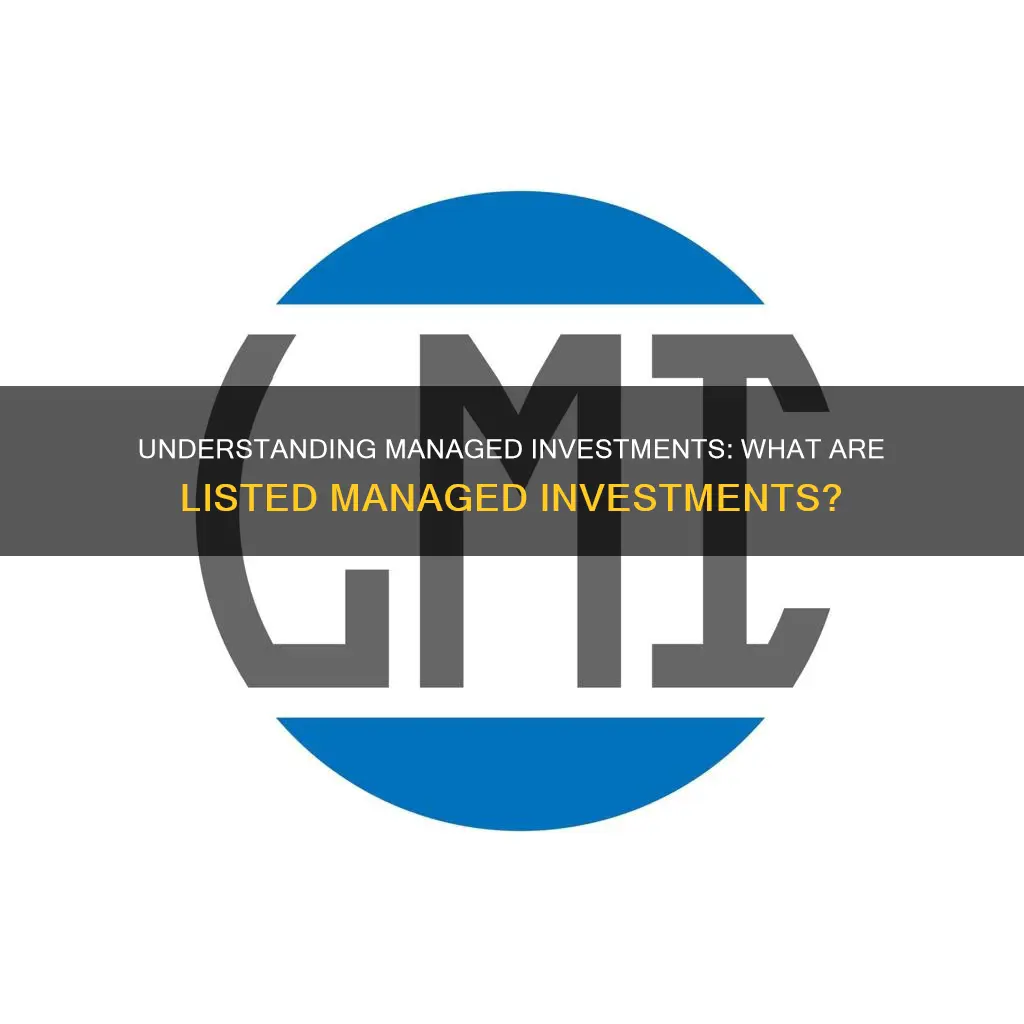
Managed funds, also known as managed investments, are a type of investment where money from different investors is pooled into one fund that is then invested and controlled by a professional fund manager. Managed funds can be listed and tradeable on the share market or unlisted and bought and sold directly through a fund manager. If a fund is listed, it can be bought and sold on the share market through a broker. If a fund is unlisted, units are bought and sold directly through the fund manager. Managed funds allow investors to diversify their portfolio and access a wide range of asset classes, companies, industries, sectors and countries.
| Characteristics | Values |
|---|---|
| Definition | A managed fund involves pooling together money from different investors into one fund that is invested and controlled by a professional investment manager. |
| Types | Managed funds can be either "listed" and tradeable on the share market, or "unlisted" and bought and sold directly through a fund manager. |
| Investment types | Funds differ in the types of assets you can invest in. You can invest in a single asset class such as shares or fixed interest, or a multi-sector option such as a Growth or Balanced fund, which contain a mix of different asset classes. |
| Units | When you invest in a managed fund, you are allocated a number of 'units'. The value of each unit is referred to as the unit price, which is calculated on a daily basis reflecting the value of the fund. |
| Unit price | If the value of the fund increases, the unit price will rise. Conversely, if the value of the fund decreases, the unit price will decline. |
| Benefits | Expert fund management, allows diversification, cost-effective, low minimum requirements, regular investment plans. |
| Investment types | Cash management trusts, fixed interest investments, international shares, agribusiness schemes, listed investment companies, listed investment trusts, property trusts, Australian equity trusts, international equity trusts, agricultural schemes, film schemes, timeshare schemes, mortgage schemes. |
What You'll Learn

Listed vs unlisted funds
Managed funds are a type of pooled investment where investors combine their money, and this pool of funds is managed by a fund manager. Managed funds can be listed or unlisted.
Listed funds trade on the share market, meaning they can be bought or sold on the share market. Investors can access them by buying units through a broker. Unlisted funds, on the other hand, are not traded on a share market. To purchase or sell units in an unlisted fund, one must deal directly with the fund manager.
The key difference between listed and unlisted funds is in their structure. A listed entity is a company structure where investors buy shares, whereas the unlisted version is a trust, so investors are buying units. For example, the listed Magellan Global Equities Fund will be very similar to the unlisted Magellan Global Fund in terms of holdings, portfolio manager, and distribution policy. However, the listed version is a company where you buy shares, and the unlisted version is a trust where you buy units.
Unlisted securities are financial instruments that are not traded on a formal exchange because they do not meet listing requirements. They are often issued by smaller or new firms that cannot or do not wish to comply with the requirements of an official exchange, such as market capitalization thresholds or listing fees. Unlisted stocks can be tracked via pink sheets or the Over-The-Counter Bulletin Board (OTCBB).
Securities must meet several requirements to be listed on an exchange. For instance, to be listed on the New York Stock Exchange (NYSE), a publicly traded stock must represent a company that surpasses an annual income or market capitalization threshold, has issued a specific number of shares, and can afford the exchange's listing fee. These requirements ensure that only high-quality companies trade on exchanges, so unlisted securities may be lower quality and riskier for investors.
Establishing a Managed Investment Trust: A Step-by-Step Guide
You may want to see also

Benefits of managed funds
Managed funds are a type of investment where investors pool their money, which is then managed by a fund manager. Here are some benefits of managed funds:
Diversification
Pooling your money with other investors gives you access to a more extensive and more diverse range of investments than if you were investing alone. Managed funds can hold various investment types, including shares, property, bonds, and cash, and they can be diversified across countries, asset classes, industries, and companies. This diversification can reduce the impact of fluctuations in an investment's market value.
Access to a Broader Range of Investments
Managed funds provide access to a broader range of investments that individual investors may not typically have access to. For example, certain markets and strategies, such as the commercial money market, require larger scale buying power that a single investor may not possess. By pooling money with other investors in a managed fund, you can gain access to these opportunities.
Professional Management
Fund managers are experienced and qualified professionals who specialise in selecting and maintaining investments. They have the expertise and market connections to make informed and timely decisions on your behalf. This allows you to invest in markets or sectors where you may have little or no experience, benefiting from the fund manager's knowledge and insights.
Affordable Investment Options
Managed funds offer affordable investment options, as the costs of managing the assets are shared among all investors. This means lower costs for individual investors, allowing more of your money to remain invested in the fund.
Compounding Effect
Reinvesting any income earned back into your principal investment can compound your investment over time. This can lead to a higher investment balance, resulting in the potential for increased income in the future.
Breaking into Investment Management: Degrees Aren't Everything
You may want to see also

Types of managed funds
There are several types of managed funds, which are a type of investment where your money is pooled with other investors and a fund manager buys and sells assets on your behalf. Here are some of the most common types:
- Single-asset managed funds: These funds invest in a single asset class, such as shares, property, or bonds. Examples include money market funds, fixed-interest or bond funds, mortgage funds, and property funds.
- Share (equity) funds: These funds invest in listed companies, either in Australia, overseas, or both, and offer the potential for higher returns but with higher risk.
- Alternative investment funds: This includes hedge funds and funds that invest in private equity, derivatives, and commodities. These can be high-risk investments, and financial advice should be sought before investing.
- Mixed-asset or multi-sector managed funds: These funds invest in a range of assets, typically with around 85% in shares and property, and the rest in cash or fixed-interest. They offer a balance between higher returns and the risk of losing money.
- Listed managed funds: These funds can be bought and sold on a stock exchange, such as the ASX. The unit or share price of a listed managed fund may be higher or lower than the net asset value (NAV) of the fund.
- Unlisted managed funds: Most managed funds fall into this category and are not listed on an exchange. To invest in an unlisted fund, you need to send an application form to the fund or use a service like the ASX's mFund.
- Open-end funds: Offered by leading mutual fund groups, these funds continuously offer and redeem shares based on each day's closing net asset value (NAV). Shares are priced daily based on their NAV.
- Closed-end funds: These funds raise money through an initial public offering (IPO) and then begin trading on an exchange. They are bought through a brokerage account and can be traded intraday.
- Mutual funds: Mutual funds are the oldest type of investment fund, pooling money from investors to buy securities. They are priced and sold to the public daily, making them a popular choice for retirement planning.
- Exchange-Traded Funds (ETFs): ETFs are listed securities that track an index or portfolio of individual securities. They offer advantages such as intraday trading, lower investment minimums, and tax efficiency compared to mutual funds.
- Hedge funds: Hedge funds pool large amounts of money from wealthy investors and financial institutions, aiming to generate returns regardless of overall market movements. They invest in a diverse range of assets, including bonds, commodities, foreign markets, and futures.
- Index funds: These funds aim to track the performance of a specific index, such as the S&P 500. They provide a high level of diversification and are known for their steady returns and lower risk.
Understanding the Portfolio Investment Process: A Comprehensive Guide
You may want to see also

How to buy and sell funds
Managed funds are a pooled investment where investors combine their money, and a fund manager oversees the pool of funds. Managed funds can be listed or unlisted. This answer will focus on listed managed funds, which are traded on the share market.
Buying Listed Managed Funds:
- Decide between active and passive funds: Active funds are managed by professionals who actively research and buy with an eye toward beating the market. Passive funds, on the other hand, are a more hands-off approach, often involving lower fees and incorporating index funds or ETFs.
- Calculate your investing budget: Consider both the minimum investment amount and how much money you are comfortable investing. Many mutual fund minimums range from $500 to $3000, but some are in the $100 range or even $0.
- Choose where to buy mutual funds: You can buy mutual funds through an employer-sponsored retirement account, directly from the fund company, through a financial advisor, or via an online brokerage. When choosing a brokerage, consider factors such as affordability, fund choices, research and educational tools, and ease of use.
- Understand mutual fund fees: Be aware of expense ratios, which represent the annual fee for fund management, and watch out for additional fees such as transaction fees or sales loads.
- Select the specific fund(s) to invest in: Consider your investment goals, risk tolerance, and the overall diversification of your portfolio. Target-date funds, for example, automatically reallocate your asset mix as you age.
Selling Listed Managed Funds:
- Review your portfolio regularly: Aim to rebalance your portfolio at least once a year to ensure it aligns with your diversification plan. For example, if one investment has performed exceptionally well and now makes up a larger share of your portfolio, consider selling off some of the gains to reinvest in other areas.
- Avoid chasing performance: Resist the temptation to buy or sell based solely on short-term performance. Instead, focus on your long-term investment strategy and the role each fund plays in your overall portfolio.
- Utilise available tools and interfaces: Many platforms offer interfaces that allow you to buy and sell managed funds with ease. These tools can provide valuable insights into the impact of sales proceeds on available cash for purchases, estimated buy and sell prices, and capital gains tax implications.
Portfolio Optimization: Strategies for Maximizing Returns
You may want to see also

Fund fees
Fees play a crucial role in the compounding returns of your investment. It is, therefore, important to understand the different types of fees associated with managed funds.
Firstly, there is the establishment fee, which is paid when you set up your managed fund account. This is typically between 0% and 5% of the amount you invest. Next, there is the contribution fee, which is paid each time you make a deposit. This is usually between 0% and 5% as well.
The management fee is another crucial component, paid to the fund's responsible entity for managing the fund, including the fees paid to the investment managers. This is typically between 0.5% and 2.5% per year and is deducted from your account balance. It is sometimes referred to as the indirect cost ratio (ICR).
Performance fees are bonus fees paid if the fund's investment performance exceeds expectations, such as surpassing its benchmark. This fee is variable and dependent on the performance of the fund relative to its benchmark.
Adviser service fees are paid to your financial advisor or broker for the advice and support they provide. This is an ongoing fee, typically ranging from 1% to 2% per year.
Lastly, buy/sell spreads are transaction fees charged by the investment manager when you buy additional units in the managed fund or redeem units.
It is important to note that higher fees do not necessarily translate to better investment returns. In fact, research suggests that paying higher fees usually results in more investment choices rather than improved returns. Therefore, it is essential to compare fees and understand the different types of fees charged by different managed funds to make an informed decision.
Savings: Invest Today, Secure Your Future
You may want to see also
Frequently asked questions
A managed fund involves pooling money from different investors into one fund that is invested and controlled by a professional investment manager. A listed managed fund trades on the share market and can be bought or sold on the share market.
Managed funds have several benefits over other types of investments. Firstly, they are a low-stress choice for investors who want an expert to conduct in-depth research of the market and investment options for them. Secondly, managed funds make it easy for investors to diversify their portfolio, with access to a wide range of different asset classes, companies, industries, sectors, and countries. Thirdly, many managed funds have low minimum requirements on how much you need to invest. Fourthly, you can also sign up for a regular investment plan or ‘regular savings plan’ with many managed funds.
There are many asset classes a managed investment scheme can invest in. Some managed funds are multi-sector, meaning that they invest in a selection of investments from more than one asset class. Some common asset classes include cash management trusts, fixed-interest investments, international shares, and agribusiness schemes.
Instead of owning the underlying securities, investors buy units in the managed fund and will receive distributions according to the amount of units they hold. The value of each unit is referred to as the unit price, which is calculated on a daily basis reflecting the value of the fund. If the value of the fund increases, the unit price will rise, and vice versa.
Managed funds are either listed or unlisted. Listed managed funds trade on the share market and can be bought or sold on the share market. Unlisted managed funds are not traded on a share market. To purchase or sell units in an unlisted managed fund, you must buy or sell directly through the fund manager.







